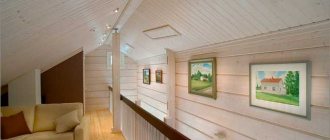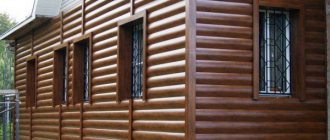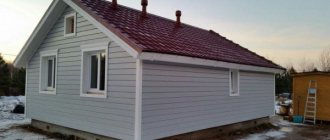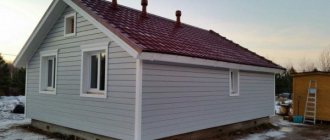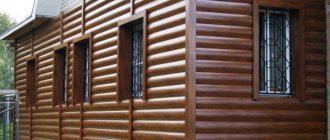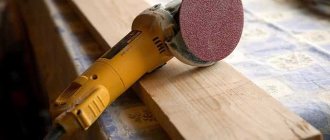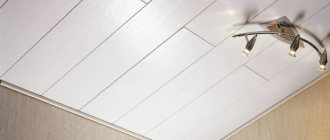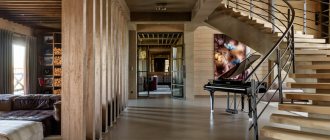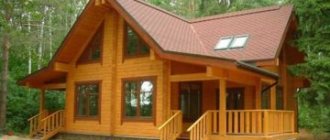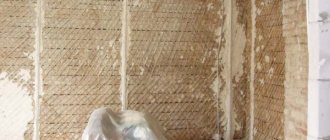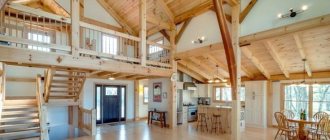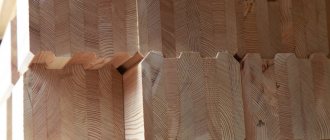The technology for the production of modern finishing materials has reached the level that the imitation surface of any natural materials (wood, stone) so accurately conveys the texture of natural elements that it can only be distinguished upon close examination.
This applies not only to the external cladding, but also to the internal one. Imitation timber can be made from high-quality wood, from different types of wood. Accordingly, the texture and color of analogues of timber finishing may differ from each other.
Wooden cladding gives the room the comfort and coziness characteristic of natural materials.
Why you should choose imitation timber for finishing the inside of a country house
First of all, natural wood meets the requirements for environmental friendliness and natural design of the room . Wood promotes a feeling of comfort and unity with nature. A country house, lined with natural wood on the inside, will mentally protect you from gray stone city buildings and help you feel the comfort and warmth of nature. It is especially important to decorate cold and gray brick or block walls.
From a practical point of view, timber trim is strong and durable, and has good sound and heat insulation characteristics. In addition, thanks to the specific design of lumber boards, a comfortable environment is created both in the space between the wall and the finish, and in the room itself.
Installation of wooden panels is not difficult, and the visual perception is no less impressive than with natural timber walls.
Insulation works
When covering stone walls on the street side, as a rule, additional thermal insulation of the walls is performed. Mineral wool is usually used as insulation here, which is vapor permeable and allows moisture to be removed from the premises to the street. These are the so-called “ventilated” facades.
The mineral wool is located either completely behind the frame bars, or is placed between them. In the second case, to ventilate moisture from the hinged cake, it is necessary to create a ventilation gap. To do this, slats 3-4 centimeters thick are screwed onto the main frame bars, which will create the required gap size for air circulation under the casing.
Whatever insulation is used, it is advisable to additionally fix it on the facade with a disc dowel. You don’t need a lot of dowels (as is the case with the bonded thermal insulation method) - one or two fasteners are enough for each slab.
If the insulation is mineral wool, then it must be protected from getting wet and from weathering of the fibers by convective currents. To do this, you need to hang a construction vapor-permeable membrane on top of an already insulated wall, before attaching the cladding boards.
Types of interior finishing
The division of finishing according to the method and nature of the interior design depends on the design solution, which involves interior cladding with wood panels.
The imitation timber finish is divided into two types:
- monolithic _ It involves finishing with wooden panels over the entire surface of the room: floor, ceiling, walls. The panels are tightly attached to each other and form a monolithic covering;
- combined . This type involves finishing different parts of the room with various materials, the main area of which is occupied by imitation timber, and additional zones are decorated with other finishing materials suitable in style and color (wallpaper, tiles, plaster).
Regardless of what type of finishing is chosen for the timber, you should purchase additional finishing parts (moldings, cornices, corners) along with the panels, which will add completeness and decorativeness to the design.
Nails
They are valued for their low cost and are the easiest to implement method of fixing wooden panels. They can be driven in by hand, or using a nailer (construction gun). Nails to imitate timber must have a protective zinc coating, and their length must be sufficient for the total thickness of the sheathing and two-thirds of the thickness of the sheathing.
The disadvantage is that the result is quite brutal, given that not everyone has enough experience to hammer a nail neatly. And in any case, the caps remain visible, which destroys the illusion of using natural timber.
More often, construction or finishing nails are purchased, which differ in size, including the size of the head. With finishing nails it is miniature and goes entirely into the wood, which is a definite plus. Screw nails are suitable for fastening particularly massive, thick panels. They will ensure the stability of the fastener, even if the material is subject to deformation.
Source yandex.net
Preparation of lumber
The material for interior finishing must meet the following parameters:
- wood quality class must be at least B (A, AB or Extra);
- The optimal board width is 10-15 cm . Narrow boards will look more like clapboard than timber, and boards that are too wide will “steal” the space of the room, which is especially ineffective for small rooms;
- using a thick board is not advisable: the best option would be a 21 mm board (or even thinner).
In addition to the size, you should pay attention to the wood from which the board is made. For an unheated room, you can use wood of any species, the main thing is that the board is treated with protective moisture-resistant and antiseptic compounds.
For a warm room, it is recommended to use mainly deciduous wood. Due to the presence of resins in coniferous wood, the release of pine resin and the corresponding aroma is not always appropriate indoors, especially if the residents are allergic.
For steam rooms or baths, it is advisable to use a linden timber finish.
IMPORTANT!
The durability and appearance of the finish depends on the quality of the material and wood.
You should not skimp on materials, since high-quality timber panels can last for many years without additional maintenance.
The boards must be well dried and stored in a dry, heated room . Before installation, the boards should be unpacked and moved for several days to the place where they will be installed so that the material adapts to the environment of the room. Some types of lumber require additional sanding and treatment with special impregnations. It is advisable to carry out the treatment of the boards before installation, and then cover them with varnish or a special stain.
How to protect a façade covered with wood from environmental influences
The structure of the timber is destroyed by the sun's rays (the surface softens, darkens and collapses).
To keep the facade in its original form, a product with ultraviolet filters is applied to the surface of the boards (at least 3 layers will be needed). But this must be done carefully - the additive can change the shade of the wood.
Constant moisture creates a favorable atmosphere for fungal growth. To protect the wood from mold, spray the facade with antiseptics. Before applying the product, clean the wood from dirt.
What types of water-repellent impregnations are there:
- In the form of a film: an invisible protective layer is formed on the boards (requires regular updating, especially on the outer facade).
- Compositions that wood absorbs into its pores. A more reliable solution.
Special chemical water-repellent solutions are diluted with water or a solvent, then the surface is treated in several layers. The composition does not affect the shade of the boards and repels water well.
In case of rotting or overgrown fungus, the surface of the timber is treated with fungicides (liquid mixed with white spirit).
The main enemies of boards are mold, mildew, moss, and insects.
A liquid based on alkyd compounds will help against insects that have already attacked the tree.
Don't forget about the fire danger.
To prevent spontaneous combustion from occurring, the surface is treated with fire retardants - substances that reduce the flammability of organic materials, slow down ignition, absorb heat and can be active or passive.
As protection, you can use not only fireproof impregnations, but also varnish, paint or enamel.
The sequence of processing the timber: first apply an anti-mold and fire agent (with fire retardants), then a water-repellent agent (water repellents), and lastly, UV protection.
Types of facade cladding with false beams:
- Solid: when the timber is mounted in the form of one monolithic wall. Thanks to the tenon-fastening system, a feeling of an ideal, continuously flat surface is created.
- With inserts of other materials. Wood can alternate with decorative tiles, wallpaper, fabric, and mosaics.
Imitation timber is often made from solid logs.
Advice: if you decide to do the interior decoration only with boards, do not take a beam that is too wide (no more than 150 mm), then the room will not seem small.
How to calculate the amount of material
Based on the width of the timber board, you can determine the actual amount of material required to finish the inside of the room.
It is necessary to determine the total surface area for cladding: calculate the area of each wall (minus openings), ceiling and floor. The area of each surface is divided by the area of one board.
This is how the quantity for each plane is calculated. All obtained indicators are added up. This way you can understand how many boards are required to cover the entire room. This method involves calculating the material for a monolithic coating.
If it is planned to use combined cladding, then a calculation is made of each plane that will need to be decorated with a board under the timber, and the amount of material is calculated in a similar way: each area is divided by the area of the board, the indicators for all planes are added up.
NOTE!
The number of elements needed for cladding should be purchased with some reserve, taking into account defective or damaged boards.
In addition to the boards, it is advisable to calculate the number of necessary elements for decorating corners, cornices, moldings, etc. It is recommended to select materials in one batch at once so that the color of the boards does not differ.
Preparing the surface for installation
How to sheathe walls from the inside? Before installing the sheathing and the panels themselves, you should prepare the walls.
All walls under the panels need:
- clear away debris;
- level as much as possible;
- wooden walls should be treated with antiseptic compounds, and block and brick walls should be primed.
After the surface is ready, a vapor barrier is laid, and, if necessary, thermal insulation and lathing for imitation.
Alternative to nails: self-tapping screws
When choosing what to attach imitation timber to, owners often lean in favor of self-tapping screws, since they can provide a secret fixation. Such hardware has the following differences:
- They reliably connect parts thanks to a wide thread pitch.
- The small diameter and specially shaped tip allow the self-tapping screw to push the wood fibers apart, so the likelihood of cracks is minimized.
- Like nails, self-tapping screws should be purchased only with galvanization, and their size is selected depending on the thickness of the sheathing and sheathing materials. Ideally, the hardware should fit halfway into the sheathing, or better yet, two-thirds.
The choice of hardware is influenced by the material from which the sheathing is made - wood or metal. If you use massive panels (for example, for flooring), a specialized solution is suitable - SPAX self-tapping screws.
Source yandexcloud.net
Thermal insulation and vapor barrier
A vapor barrier film should be attached to the prepared surface to prevent the formation of condensation moisture inside the skin . To do this, the film is attached using a stapler (to a wooden surface) or using sheathing beams (to a brick or concrete surface) so that the smooth side of the vapor barrier is in contact with the wall.
Cover the entire surface for cladding with film. The seams of the film should be overlapped by 100 - 150 mm and secured with tape.
CAREFULLY!
The location of the vapor barrier film should be free, without tension.
Otherwise, the membrane may break through during the installation of sheathing or thermal insulation, as well as during the natural shrinkage of the walls of the house.
In some cases (in the absence of external thermal insulation of the house), the installation of thermal insulation materials is required. In this case, when calculating the sheathing pitch, not only the length of the cladding board under the timber is taken into account, but also the width of the insulation. Roll or block insulating material is placed tightly between the sheathing guides without gaps or joining holes.
Do-it-yourself selection and installation of lathing
For a house made of wood, it is advisable to use wooden blocks with a cross-section of 40 - 50 mm . The wood should be thoroughly dried and treated with antiseptic and moisture-resistant agents. Metal profiles are used for installation of cladding in concrete or brick walls.
Installation of the sheathing is carried out by attaching the guides in a vertical position in increments of 600 to 800 mm.
Corner guides should be mounted in such a way that there are two bars at each corner.
IMPORTANT!
When installing the sheathing, you should check the uniformity of installation using a level.
In addition to double corner strips, you should additionally install bars in places where shelves or other hanging elements are attached that can weigh down the structure.
The wiring should be pulled between the sheathing, insulated with a special corrugated tube.
Having completed the sheathing over the entire area, you should begin installing the facing panels.
How to fasten timber indoors
Boards under timber for internal cladding can be attached in several ways:
- fastening into a groove . The method differs in that the heads of the hardware are in a hidden position. The screws are screwed into the base of the tenon at an angle of 45°. When installed correctly, fasteners screwed flush with the beam will be securely hidden;
- driving in elements from the outside . The nails should be driven on top of the board. To do this, it is recommended to use decorative hardware with original caps, or use special plugs, sometimes putty with shavings is used.
- use of clamps . The most optimal method of fastening panels. More details in the video below.
Installation using clamps can be done on walls, but most effectively on the ceiling. Galvanized clamps in the form of brackets are attached to the board; they are the connecting elements between the panels. Fastening with clamps is used most often.
Wall paneling
The technology for installing panels under timber involves a sequence of steps (photo below):
- stepping back from the corner no more than 50 mm, you should install the first panel, then the first row;
- It is recommended to install the boards with the tenons facing up;
- a small gap (up to three millimeters) should be left between the panels for thermal expansion;
- when designing openings, corners and windows, the verticality of the cuts should be controlled;
- installation of panels is carried out from bottom to top along each plane;
- After installing the main panels, transitions from one plane to another should be made using skirting boards.
NOTE!
The panel should be fastened strictly perpendicular to the sheathing.
It is most effective to fasten boards using clamps: the fastening elements are hidden, and the covering looks like a single sheet.
If it is necessary to coat the cladding with special protective and antiseptic agents, then choose compositions that match the wood and the nature of the room.
Thus, imitation timber will help to translate into reality design solutions for creating a natural interior indoors. Imitation timber is a durable coating, so you won’t have to think about decorating the inside of your home for several years: the panels will create warmth and comfort. If the cladding material is made of coniferous wood, then in addition to comfort, the room will be saturated with the aromas of pine needles and forest.
What are the advantages
Wooden panels of varying thicknesses are used to cover the house inside or outside.
After finishing with such material, people get the impression that the house is entirely made of timber; it can be used to cladding houses made of various building materials.
The main advantages of finishing a house with imitation timber:
- this material has high thermal insulation characteristics, so you not only decorate, but also insulate the facade;
- this is a natural material, it is environmentally friendly and safe for human health, so it can be used inside the home without fear;
- the material is relatively cheap and with its help any building can be made to look like a wooden house;
- used for finishing buildings made from a wide variety of building materials;
- easy and simple to install;
- has a long service life;
- improves the sound insulation characteristics of the house;
- has little weight.
Among the disadvantages of imitation timber, the following should be noted:
- since this is a wooden material, it has a high fire hazard; to reduce it, the panels are treated with fire retardants;
- if the integrity of the structure is compromised, the material may begin to rot and deform, so the house must be constantly monitored and defects that appear must be immediately eliminated;
- Periodically it is necessary to treat the surface with antiseptics and open it with varnish. If high-quality materials are used, then such treatment should be done once every 5-8 years;
- if rare wood species are used, the price of such products will be high.
